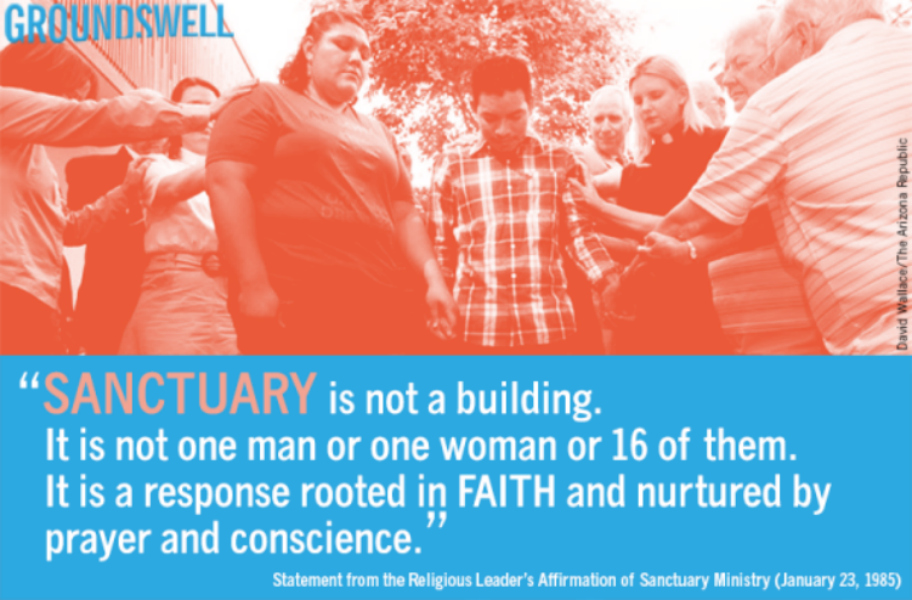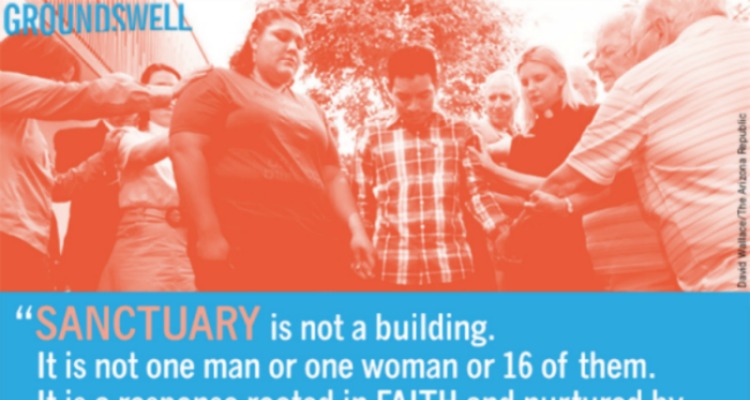In the year 399 in Constantinople, the wealthy government official Eutropius, a man known for his lavish lifestyle and attempts to strip churches of their right to serve as a sanctuary for the persecuted, entered sanctuary when he feared for his life. Eutropius took refuge in none other than the church of the Patriarch of Constantinople, John Chrysostom. The occasion of this powerful and corrupt government official who had previously critiqued the very practice he was now invoking moved Chrysostom to deliver two powerful sermons on the need for sanctuary and on the vanity of riches.[1] Chrysostom says to Eutropius:
Where are now thy cup-bearers, where are they who cleared the way for thee in the market place, and sounded thy praises endlessly in the ears of all? They have fled, they have disowned thy friendship, they are providing for their own safety by means of thy distress. But I do not act thus, nay in thy misfortune I do not abandon thee, and now when thou art fallen I protect and tend thee. And the Church which you treated as an enemy has opened her bosom and received thee into it; whereas the theatres which you courted, and about which you were oftentimes indignant with me have betrayed and ruined thee. And yet I never ceased saying to thee “why doest thou these things?” “thou art exasperating the Church, and casting thyself down headlong,” yet thou didst hurry away from all my warnings. And now the hippodromes, having exhausted thy wealth, have whetted the sword against thee, but the Church which experienced thy untimely wrath is hurrying in every direction, in her desire to pluck thee out of the net.
Eutropius’ example reminds us of a fundamental dimension of the ancient practice of church sanctuary—it is for all whose life is threatened. While such an affirmation may raise ethical questions about what exactly we mean when we say that it is for all, unless we have ceased to believe in the God of life who wills the life of all, then sanctuary extends even unto those who may have previously persecuted us and our communities.
But this universal dimension of sanctuary is made possible to the degree that the lives of the most vulnerable in our midst are protected, and in a world where laws can be bought and injustice can be legalized, the church must make an unequivocal preferential option for those poor whose very embodiment already makes of them an “illegal” presence in this land “of the free” where some are free and the rest are detained for profit.[2]
~ ~ ~
Jim Corbett, one of the most profound and prophetic thinkers in the 1980’s sanctuary movement wrote the following about Salvadorans fleeing violence in Central America:
If the churches continue to ignore the Salvadorans’ desperate need to avoid capture, the American public will continue to see the refugees, rather than their persecutors, as illegals.
Actively asserting the right to aid fugitives from terror means doing it—not just preaching at a government that is capturing then deporting them, not just urging legislation that might help future refugees. With people in our midst being hunted down and shipped back, denouncing the terror while ignoring the victims simply teaches the public how to live with atrocity.
Much more than the fate of the undocumented refugees depends on the religious community’s participation and leadership in helping them avoid capture. If the right to aid fugitives from government-sponsored terror is not upheld in action by churches— regardless of the cost in terms of imprisoned clergy, punitive fines, and exclusion from government-financed programs—the loss of many other basic rights of conscience will certainly follow. No one who lives in this century can have missed that lesson.[3]
In the 1980s hundreds of churches did mobilize to provide refuge, and a few are still doing it today.[4] But on Thursday, November 16th, over 130 campuses across the country mobilized to ask that their campuses become a sanctuary campus.[5] While this movement is more focused on preventing universities from collaborating with immigration officials in regards to the legal status of students, it also asks that ICE agents be prevented from entering campuses. With this latter point, a sanctuary campus begins to approximate the historic notion of churches as sites of sanctuary.

In this brief reflection we will not enter into the theological foundations that can allow such a place as a university to serve as a holy (“sanct-ified” sanctuary) site of refuge, but instead we will briefly point to what can happen when a university lives into its prophetic call.
Twenty-seven years ago, on November 16, 1989, six Jesuit priests, their housekeeper and her daughter, were assassinated at the Universidad Centroamericana José Simeón Cañas (UCA) in San Salvador, El Salvador.[6] The university and its leadership had publicly committed themselves to stand in intimate solidarity with the poor, the displaced, and the persecuted. The unambiguous position the university had taken made it a primary target for state terror—and state terror it received through bombs and bullets.[7]
Perhaps our North American universities will never have to face such a degree of state terror, or perhaps it is only a matter of time until the university becomes a threat to “democracy” and “national security.”
~ ~ ~
Those of us who work or study in the privileged and often sheltered spaces that are U.S. universities, especially those of us in faith-based institutions, must ask ourselves if our universities are willing to bear the same fate as the poor, the displaced, and the persecuted? Are our most prized Catholic, Presbyterian, Lutheran, Baptist, Methodist, Episcopalian, or nondenominational institutions willing to live in the shadow of the cross, “regardless of the cost in terms of imprisoned clergy, punitive fines, and exclusion from government-financed programs”?
To live in the shadow of the cross may be a heavy burden, but as Christian universities, do we have another choice when our very identity and mission are at stake?
Lastly, let me say that a sanctuary church or a sanctuary university is only possible because there exists a community of saints, living and deceased, whose existential compass is guided by a vision of humanity that extends beyond any and all national codifications of who belongs and who is expendable and deportable. It is this community of saints that resists any government attempts to “twist Christ’s body in its own image.”[8]
Perhaps ultimately it is only a community that can provide sanctuary, and in doing so, they/we enact the living holiness that makes possible the very concept and practice of sanctuary as a holy place of refuge.
~ ~ ~
[1] You can find the homilies here: http://orthodoxchurchfathers.com/fathers/npnf109/npnf1034.htm#TopOfPage
[2] http://www.huffingtonpost.com/entry/private-prison-stocks-trump_us_582336c5e4b0e80b02ce3287
[3] Jim Corbett, quoted in Mirian Davidson, Convictions of the Heart, (Tucson, AZ: University of Arizona Press, 1988), 60.
[4] http://www.sanctuarynotdeportation.org
[5] #sanctuarycampus | https://actionnetwork.org/forms/join-the-sanctuarycampus-movement
[6] http://ignatiansolidarity.net/blog/2009/11/05/the-uca-martyrs-challenge-and-grace/
[7] “At the UCA we have known 18 bombings and martyrdom. But it will also produce a stronger sense of identity and mission, along with more lasting and universal good.” http://www.xavier.edu/mission-identity/trustees/Justice-in-Higher-Education.cfm
[8] Professor Katie Grimes, PhD recently wrote (on facebook): “Family, like the Body of Christ, has no borders. We can’t let the government twist Christ’s body in its own image.”

You must be logged in to post a comment.